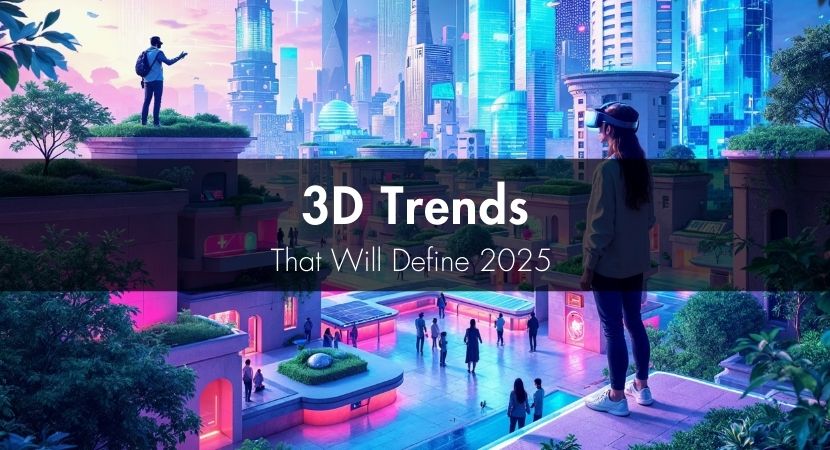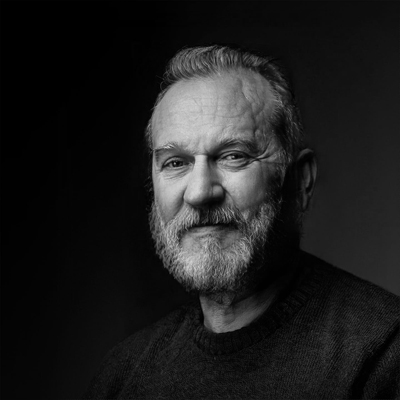
The world of 3D visualization is evolving at an unprecedented pace, with new technologies shaping the way 3D artists, architects, and designers create and present their work. As we move into 2025, several key trends are set to redefine the industry. From artificial intelligence to real-time rendering, these advancements will not only enhance creative workflows but also improve efficiency and accessibility. Amidst all these changes, one thing remains constant: our reliable render farm service, ensuring fast and seamless rendering for your 3D projects. But now, let's check out, what changes are awaiting us in 2025!
This article will go deeper into the major 3D trends set to dominate 2025, offering some insights into their impact on the industry, technological advancements driving their evolution, and practical real-world applications. From cutting-edge AI-driven design tools to revolutionary real-time rendering techniques, we will explore how these trends reshape workflows, enhance creative possibilities, and redefine efficiency in fields such as architectural visualization, gaming, animation, and product design. By understanding these innovations, 3d artists can stay ahead of the curve, adapt to industry shifts, and leverage new opportunities to elevate their work in the world of 3D technology.
1. Integration of Artificial Intelligence (AI).
Artificial Intelligence (AI) is revolutionizing 3D workflows by automating tedious tasks—enhancing creativity for some while 'killing' it for others. However, this is a broad topic that would be better analyzed in a more in-depth article.
For a glimpse into the transformative potential of AI tools in the 3D industry, be sure to check out our previously published article, AI Meets 3D Art: A Blessing or a Curse?, where we explore the opportunities, challenges, and creative implications of AI-driven workflows.
From AI-assisted modeling to procedural material creation, the advancements mentioned above are transforming how professionals approach design and visualization.
AI-Powered Automation in 3D Workflows.
AI-driven tools are streamlining tasks such as UV unwrapping, texture generation, and scene lighting. Applications like NVIDIA’s AI denoising and Adobe Firefly’s AI-generated textures significantly reduce production time while maintaining high-quality results.
Enhancing Creativity with Generative AI.
Generative AI enables artists to quickly iterate designs, providing suggestions for layouts, compositions, and even architectural elements. This empowers creators to explore new ideas effortlessly while maintaining control over the final output. Here, someone could ask the question: What is the difference between AI and Generative AI? We'll answer as simply as possible that AI is a broad field that encompasses various technologies designed to mimic human intelligence, including machine learning, natural language processing, computer vision, and automation. It is used for tasks like data analysis, pattern recognition, decision-making, and automating repetitive processes. Generative AI, on the other hand, is a specialized subset of AI focused on creating new content, such as text, images, music, or 3D models, using advanced machine learning techniques like deep learning and neural networks. While AI is generally used to process, analyze, and optimize data, Generative AI goes a step further by producing entirely new and original outputs based on training data.
You can check this video from Harvey Newman talking about how AI is changing the future of 3D art:
2. Virtual Reality (VR) and Augmented Reality (AR).
The rise of VR and AR continues to blur the lines between digital and physical experiences. These technologies provide clients with interactive and immersive environments, reshaping architectural visualization and product design.
Immersive Architectural Visualization.
With VR, 3d artists can create fully explorable virtual spaces, allowing clients to walk through buildings before they are built as there are several software that enable real-time interaction within 3D models.
Below is a nice presentation by Joseph Kim presenting Yulio, a platform designed to turn 3D models into immersive virtual tours that can be viewed on multiple devices, including phones, tablets, computers, and VR headsets. It allows architects and designers to share and present their ideas more effectively using 360° renderings and VR presentations.
Augmented Reality for Design Reviews.
AR is revolutionizing on-site design reviews by overlaying digital models onto real-world environments. Apps like ARki and Fologram help designers and clients visualize spatial relationships and material choices in real-time.
Here is a video explaining the future of augmented reality:
3. Real-Time Rendering.
Real-time rendering is changing the way visualizations are produced, offering instant feedback and interactive capabilities that streamline the creative process.
Real-Time Software Advancements.
There are many new features in several Real-Time software providing unparalleled realism with real-time global illumination and ray tracing, making presentations more interactive and visually stunning. Nevertheless in huge complex scenes, the traditional methods keep the first place in artists' hands.
Client Collaboration Through Interactive Visualization.
Clients can now make design decisions dynamically through real-time rendering. Tools like Chaos Vantage and Omniverse enable real-time adjustments to lighting, materials, and compositions during live sessions.
4. Photorealistic Renderings.
The demand for hyper-realistic visualizations is at an all-time high, with advancements in rendering engines pushing the boundaries of realism.
Cutting-Edge Rendering Techniques.
Technologies like path tracing and AI-assisted denoising are allowing artists to achieve near-perfect realism. V-Ray, Corona Renderer, and Redshift continue to improve physically accurate lighting and shading.
Material and Texture Innovations.
New procedural material libraries, such as those from Quixel Megascans and Adobe Substance, provide photorealistic textures with micro-surface details, enhancing authenticity. Nevertheless, you can study and practice with your own PBR materials. In this tutorial below Nuno Silva explains how to make realistic PBR materials from your photos in minutes.
5. Sustainability and Biophilic Design.
Environmental consciousness is playing a bigger role in 3D design, with an emphasis on sustainable materials and nature-inspired aesthetics.
Eco-Friendly Architectural Visualization.
Renderings now emphasize sustainable features like green roofs, energy-efficient facades, and solar panels. Tools like ClimateStudio and Ladybug assist in environmental analysis and design. If you're not familiar with Sustainable Architecture you can watch the 10 Eco-Friendly houses in the video by Going Green.
Biophilic Design in 3D Modeling.
Biophilic design is rooted in the idea that humans have an innate connection to nature, yet modern lifestyles have distanced us from natural environments. Since most people spend 93% of their time indoors, biophilic design aims to integrate nature into built spaces, allowing us to experience its benefits within our homes.
The video below explores seven key principles of biophilic design:
- Light & Air
- Vegetation
- Water
- Natural Materials & Colors
- Patina & Natural Aging
- Outdoor Spaces & Minimal Footprint
- Relationship to Place
Biophilic design is more than just adding plants; it’s about fostering a deep relationship with nature through architecture, materials, and spatial design. To live healthier and more sustainably, we need to rethink how we design our homes, suburbs, and cities, ensuring they align with natural ecosystems rather than disrupt them. 3D artists need to conquer this knowledge to be prepared and aligned with their clients' needs. 3D artists must master this knowledge to stay prepared and aligned with their clients' evolving needs.
6. Cloud-Based Collaboration.
Cloud technology transforms how 3D artists collaborate, making file sharing and teamwork more seamless than ever.
Cloud Rendering and Storage.
Cloud platforms like RebusFarm allow for high-performance rendering without expensive hardware and services like Google Drive and Dropbox facilitate instant project access. In this article you can learn How To Optimize Your Project For Online Cloud Rendering.
Remote Teamwork and Version Control.
In the modern era of digital collaboration, remote teamwork has become an essential aspect of architectural visualization, game development, and 3D design workflows. With teams often spread across different locations, cloud-based platforms provide a seamless way to manage projects, ensuring that everyone stays on the same page. Tools like Autodesk BIM 360 and Blender’s Asset Library allow multiple contributors to work on the same project without the risk of data loss, version conflicts, or overwritten files. These platforms enable real-time synchronization, meaning changes made by one team member are instantly available to others, fostering efficient communication and a streamlined workflow. This not only reduces errors and redundancies but also allows for faster iterations and improved project management, ultimately enhancing productivity and creativity.
Beyond simple file sharing, version control plays a crucial role in maintaining an organized and efficient multi-team workflow. Features like automated backups, file history tracking, and rollback options ensure that past iterations of a project are never lost, allowing teams to experiment freely without the fear of irreversible mistakes. Whether working on complex BIM models in Autodesk BIM 360 or refining shared assets in Blender’s Asset Library, version control helps prevent workflow disruptions and fosters a more collaborative, error-free production pipeline. By leveraging these technologies, teams can maintain greater flexibility, security, and adaptability, ensuring projects stay on schedule while meeting the evolving demands of clients and stakeholders.
7. Advanced 3D Capture Techniques.
Technologies like Gaussian splatting and LiDAR scanning are redefining how real-world objects are translated into digital form.
Gaussian Splatting for Realistic Scans.
A breakthrough in 3D scanning, Gaussian splatting allows for more accurate, high-quality scans by capturing fine details like texture transparency and depth. But What's Gaussian splatting? Check these Bad Decisions guys explaining it in a comprehensive and funny way!
Scanners and Photogrammetry in 3D Modeling.
The use of 3D scanners and photogrammetry in architectural visualization provides hyper-detailed environment captures, making digital replicas indistinguishable from reality. To learn more about 3d scanning check this Top Five 3D Scanner Apps comparison by JackIsBuildingKIRI:
Conclusion.
The 3D industry is on the brink of a transformative year in 2025, driven by AI, real-time rendering, VR/AR, and sustainable design. These trends will redefine how artists, architects, and designers create, collaborate, and present their visions.
I hope you found this article both informative and comprehensive, providing valuable insights to stay informed and keep up with the latest trends in our industry.
Kind regards & Keep rendering! 🧡

About the author
Vasilis Koutlis, the founder of VWArtclub, was born in Athens in 1979. After studying furniture design and decoration, he started dedicating himself to 3D art in 2002. In 2012, the idea of VWArtclub was born: an active 3D community that has grown over the last 12 years into one of the largest online 3D communities worldwide, with over 160 thousand members. He acquired partners worldwide, and various collaborators trusted him with their ideas as he rewarded them with his consistent state-of-the-art services. Not a moment goes by without him thinking of a beautiful image; thus, he is never concerned with time but only with the design's quality.

